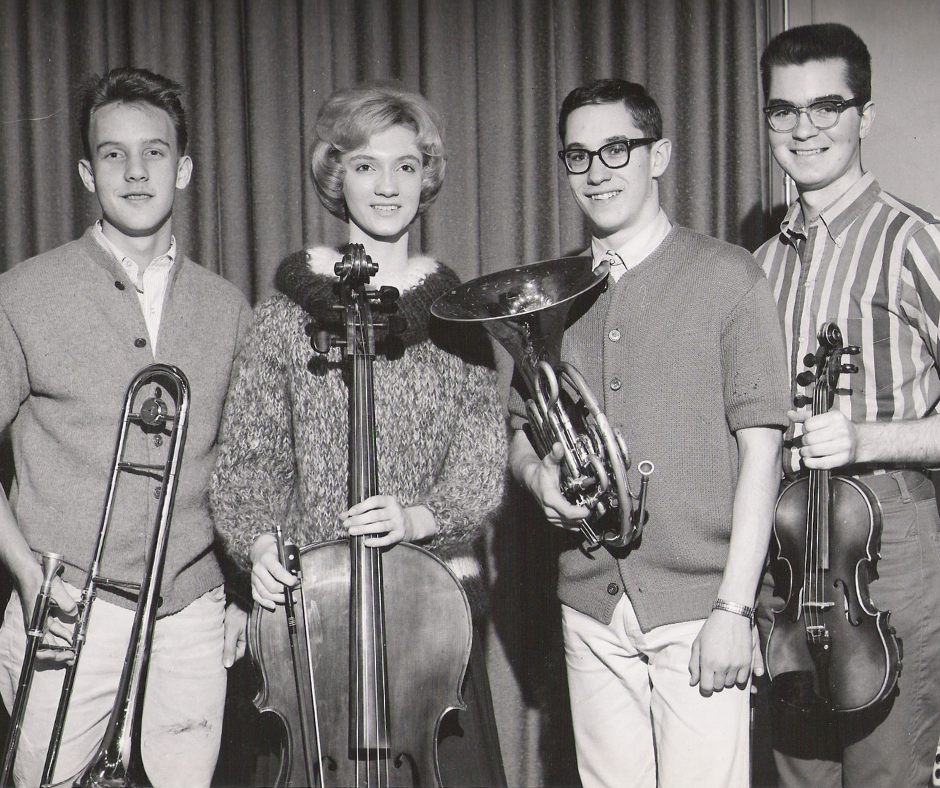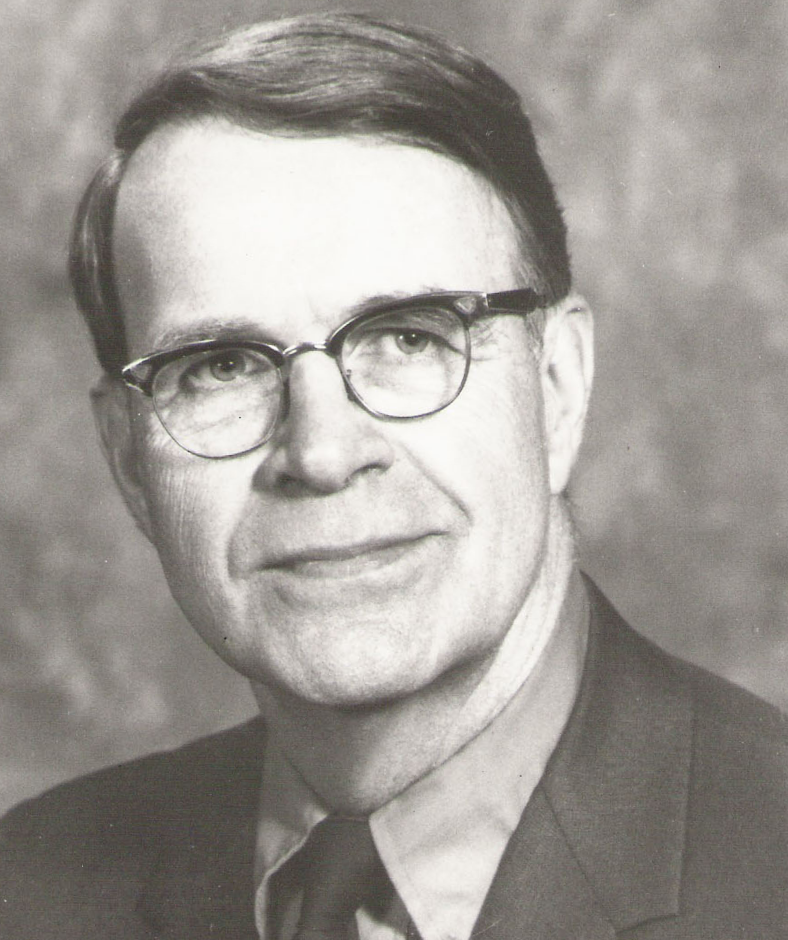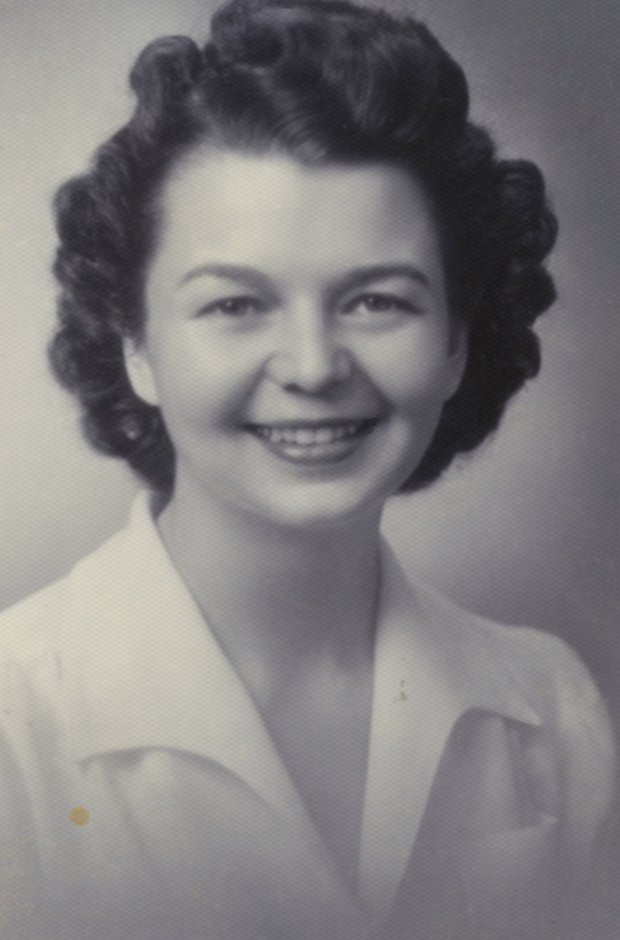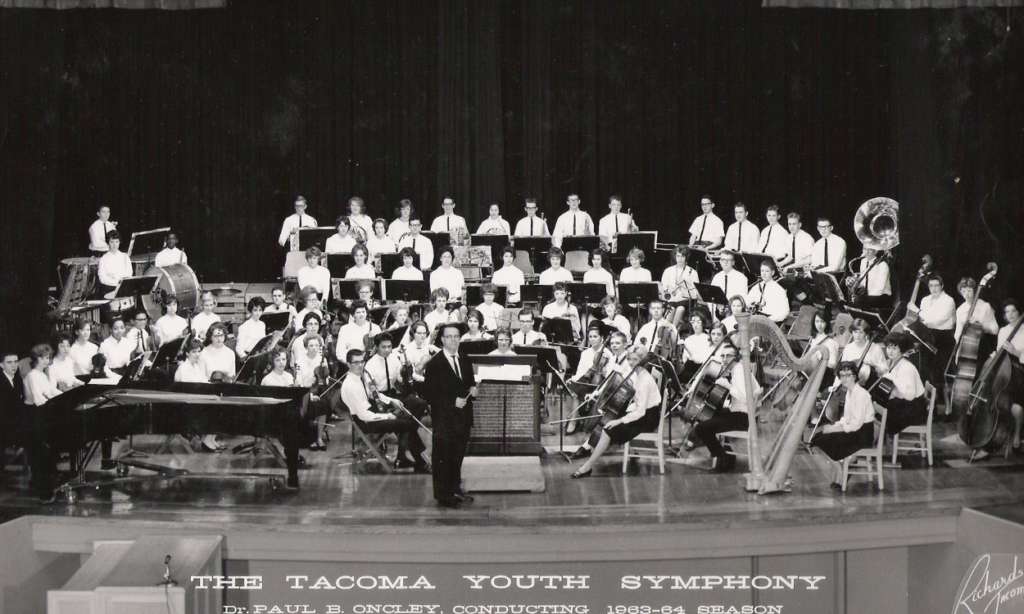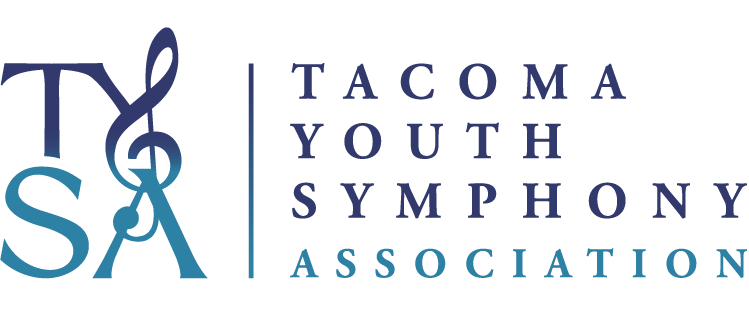History of TYSA
Building musical leadership since 1963.
Video: The Tacoma Historical Society Celebrates 60 Years of TYSA
History of the Tacoma Youth Symphony Association
In the summer of 1963, the Tacoma Arts for Youth Council, an arts advocacy organization comprised of community volunteers, offered a summer string orchestra program at Pacific Lutheran University. The 28 students who participated fell in love with the experience and asked if the ensemble could continue during the school year. Virginia Morrison, a member of the council, was determined to keep such an opportunity available for Tacoma youth.
Mrs. Morrison was born in Tacoma in 1919, and as a student at Lincoln High School, played clarinet in the marching band, orchestra, operettas and musicals. Those experiences clearly impacted her, as she went on to earn a Bachelor of Arts in Music and a Conservatory Diploma in Music Teaching from Whitman College. It was always her dream to start a youth symphony, and having her own children only strengthened that desire.
She persuaded a conductor she knew, Dr. Paul Oncley, to volunteer his Saturday mornings for the following school year to rehearse with the new Tacoma Youth Symphony. Rehearsals were held in the new University of Puget Sound music building, and concerts were held at PLU’s Eastvold Auditorium and other local schools. The Tacoma Youth Symphony was born! Mrs. Morrison led the fledgling organization for more than a decade, overseeing significant growth as well as two international tours.
Virginia and her husband, Judge E. Albert Morrison, would go on to support the Tacoma Youth Symphony Association for the rest of their lives. The couple had four children, three of whom participated in the Tacoma Youth Symphony. Virginia joked that the Youth Symphony was her fifth child. With such origins, it should come as no surprise that the organization has cultivated a family-like atmosphere. That atmosphere has thrived despite TYSA’s dramatic growth and change in the decades which followed.
After Paul Oncley’s initial turn at the podium (1963-1965), the Tacoma Youth Symphony has since been led by a series of illustrious conductor/educators: C. Irvin Wright (1965-1981), Stanley Chappel (1977-1978), Steve Amundson (1980-1981), Harry Davidson (1981-1995), Dr. Paul-Elliott Cobbs (1996-2024), and Dr. James O. Welsch (2024-present).
International Tours
Just a few years into the organization’s existence, Tacoma Youth Symphony became an internationally recognized ensemble when, in 1970, the orchestra travelled to Switzerland to participate in the International Festival of Youth Orchestras. The orchestra participated in the same festival again in 1975, when it took place in Scotland. At both festivals, Tacoma Youth Symphony took top honors. A dramatic accomplishment for such a young organization, these early experiences also set the stage for more touring in the decades to come.
The orchestra visited Europe again in 1983, with 100 musicians and chaperones spending 25 days performing and exploring in England, Holland, France, Switzerland, and Austria.
Growth and Development
In 1964, the Tacoma Junior Symphony (later renamed Tacoma Debut Orchestra and today called the Tacoma Junior Youth Symphony) was formed as a training orchestra for the Tacoma Youth Symphony. For its first several years, it was a full symphony orchestra, made up of a wide range of ages and abilities. As other new ensembles were developed in the years to come, the Junior Symphony gradually narrowed in focus, becoming an ensemble intended for middle- and high-school age students.
As this program from 1971 demonstrates, the Youth Symphony and Junior Symphony would often share a stage in performances, which took place at a variety of local schools. The Junior Symphony has been conducted by John Howard Walters (1964-1967), Alan Wilkie (1967-1979), Dale Johnson (TDO, 1979-2013), Dr. Paul-Elliott Cobbs (TJYS, 1997-2022), and Joe Dyvig (2022-present).
In 1982, the Tacoma Little Symphony debuted as a training ground for elementary and middle school string players. Later renamed the Tacoma String Symphony (TSS), it remains the starting point for many of the string players in the TYSA family. During Harry Davidson’s tenure as Youth Symphony conductor (1981-1995), Kristen Turner worked with the young string players for the first part of the rehearsal and then Mr. Davidson would rehearse students for the last half hour. Karla Epperson took over the leadership of TSS in 1997, and it is currently directed by Karen Helseth.
In 1985, educator Rex Turner created the Symphonic Winds Training Program (SWAT), giving woodwind, brass, and percussion students an opportunity for specialized coaching that paralleled the string-specific ensembles within TYSA. Mr. Turner led SWAT until 2000, followed by Elizabeth Paterson (2000-2002), David and Tracy Cripe (2002-2005), John M. Wetherington (2005-2009), and Elizabeth Ward (2009-2011). The Tacoma Youth Wind Sinfonia, conducted by David and Tracy Cripe, served as a younger version of SWAT from 1999-2002.
By 1985, with substantial growth in both numbers and reputation, it was decided that TYSA should have a second full symphony orchestra. This orchestra would be considered a performing orchestra – as opposed to the training ensembles mentioned above – and perform three concerts a year. The Tacoma Young Artists Orchestra (TYAO) was created, with Dale Johnson as its conductor.
Mr. Johnson has remained with the TYAO throughout its history. The ensemble has performed alongside the Tacoma Youth Symphony during seasonal concerts as well as joined the TYSA’s touring orchestra.
In addition to his leadership of the TYAO, Mr. Johnson was instrumental the establishment of two other important TYSA programs, the String Orchestra Festival for middle and junior high school students (founded 1982) and the Evergreen Music Festival (founded 1984), both of which continue to this day.
The String Orchestra Festival provides a non-competitive environment for 1,250 middle and junior high school musicians to perform as well as listen and learn. Coming from throughout the Puget Sound area, full school orchestras meet at The Evergreen State College in Olympia, perform for one another, and listen to TYSA chamber musicians. A month prior to the festival, school orchestras are provided with festival music to learn. In the huge festival orchestra setting under renowned maestros, they join together to perform these works.
The Evergreen Music Festival also originated at the Evergreen State College in Olympia. It is comprised of two sessions, Session I for younger (pre-high school) students, and Session II for high school students. Both sessions offer students large ensemble opportunities, theory classes, small group instruction from experienced teachers, and a chance to meet other kids who are passionate about music. Session II also offers chamber music, choir and performance opportunities. In keeping with the TYSA’s tradition of partnering with a variety of local educational institutions, the most recent Festival was held on the campuses of the Pacific Lutheran University and the University of Puget Sound.
The most recent standing ensemble to be formed within the TYSA organization is the Tacoma String Philharmonic. Established in 1997, it was originally created for slightly older beginning and intermediate string players. It provides a second step for young string players, after the Tacoma String Symphony. The founding conductor was Karla Epperson, and the group is now led by Dr. Anna Jensen.
Education and Outreach
In addition to these ensembles, which provide a continuity of education and performance experience for youth aged 6-21, TYSA has also sponsored a variety of smaller ensembles and educational programs over its 60-year history.
For example, TYSA conductors and coaches have led a variety of instrument-specific ensembles. These include the Tacoma Youth Brass Ensemble (directed by Elizabeth Ward), the Tacoma Youth Percussion Ensemble (directed by Jeff Lund), and the South Sound Strings Harp Ensemble (directed by Patricia Wooster).
In more recent years, TYSA has partnered with the Hammond Ashley Double Bass Workshop to offer educational opportunities for students and teachers alike. The Tacoma Young Violin Program is for young people (ages 6-10) who wish to explore and discover the violin. Students learn beginning violin skills, note reading, rhythmic foundations, how to play together in a group, all while also making new friends. In the summer of 2022, Tacoma Youth Symphony conductor Paul-Elliott Cobbs introduced the first-ever Symphonic Jazz Workshop, open to students from 8th grade through age 21.
In addition to these specific programs, the TYSA organization has, throughout its history, offered educational concerts and school visits as a means of outreach to music students and music educators throughout the Tacoma area, expanding beyond the hundreds of students actively participating in TYSA ensembles to make a larger educational impact.
Return to Touring
A generation after the orchestra first toured in Europe in the 1970s and early 1980s, the ensemble has made several trips in the 21st century as well. In 2000, the Tacoma Youth Symphony was chosen to perform at Carnegie Hall in New York City after a rigorous application process. The orchestra received and accepted an invitation to perform there again in 2005.
Selected members of the Tacoma Youth Symphony and Tacoma Young Artists Orchestra embarked on this once in a lifetime experience. Following city tours, rehearsals and masterclasses with Juilliard teachers, these young musicians performed Copland’s Tenderland Suite and Stravinsky’s Firebird to a full house. They received an immediate standing ovation from the savvy New York audience as well as four curtain calls.
I remember the last time I worked with the TSS, and I said to them, “We’re going to Carnegie Hall. Youth Symphony has gone to Carnegie Hall twice, and chances are you will go, too. But we didn’t just start preparing for it two months beforehand, we prepared for it when they were in TSS. So, we’re going to prepare today. We’re going to pick our best three pieces, and we’re going to pretend we’re at Carnegie Hall, and the parents can applaud for us, and we’ll do it just like the big kids.”
Just a few years later, in April 2008, the Tacoma Youth Symphony performed in the National Festival of the States held in Washington D.C. Performing groups were selected based on recommendations from state & national music educators, governors, senators, congressional representatives and by audition, and selected participants from the Tacoma Youth Symphony and Tacoma Young Artists Orchestra traveled to our nation’s Capital to perform in three concerts.
Most recently, selected members of the Tacoma Youth Symphony and the Tacoma Young Artists Orchestra performed in the renowned Boston Symphony Hall in May 2013. This memorable experience was dedicated to the resiliency of the citizens of Boston following the Marathon Bombing. In addition to the opportunity to perform, a wonderful educational opportunity was provided through tours of historic monuments, parks and museums in Concord, Lexington, Salem and Boston.
Leadership
In addition to the skilled leadership of ensembles by their conductors, and the countless hours provided to students by coaches, the Tacoma Youth Symphony Association has benefited from the guidance and leadership of those who have held the position of Executive Director.
Following Virginia Morrison’s work to establish the organization and guide it through its first growth as a volunteer leader, Shirley Getzin became the first paid staff member in 1976, serving as executive director until 1997. As explored above, these two decades saw enormous growth and expansion of the organization, successes that would not have been possible without her steady hand at the helm.
Dr. Loma Cobbs then led the organization for nearly three decades, serving as executive director from 1997 through 2021. Upon her retirement, she was recognized for her remarkable work in leading the organization through good and bad times with tight financial control, steadfast loyalty, high integrity, and a love for the students.
“We have historically said that we have a family atmosphere, and I think that is genuine. That is a culture we have worked to develop, and that’s why the mentor program is so successful. It’s like a big sibling helping a younger sibling. And that culture wasn’t created by accident. The people that have been selected for various positions, from conductors to executive directors, everyone down to the coaches, everybody, have been very specifically selected because of their attitude. They are thinking about these young people, these little ones, who need some coaxing sometimes, or a kick in the butt. But it’s a big family. You don’t see that in every organization. That’s something we can be tremendously proud of.”
Dr. Loma Cobbs, former executive director
In spite of the challenge of a leadership transition during a pandemic, Dr. Cobbs worked closely with her successor, Dr. Anna Jensen, a performer, conductor, and nonprofit arts administrator who was already a part of the TYSA family, and who is now applying her talents and energies to leading the organization forward as executive director.
The Tacoma Youth Symphony Association has been most fortunate to benefit from such skilled and committed leadership from women who are equally dedicated to musical excellence and educational quality. For an organization to count just four leaders in sixty years is a remarkable statement about the continuity of the organization in the Tacoma community.
Legacy
In its first sixty years, TYSA has grown into an organization that provides not just performance opportunities for talented young musicians, but a fully-developed educational program which supports students from second grade through age 21 and beyond. In addition to the opportunity to play within an orchestra under the leadership of skilled conductors and educators, TYSA students learn about music theory and history, and have opportunities to step up to roles as leaders, mentors, and coaches.
Cellist Sarah Yamamoto, who worked her way from TSS to TYS between 2005 and 2012, describes the many ways in which TYSA experiences shaped her development:
“I played cello and went to EMF every summer, also serving as a cello coach for Session I students after I had outgrown that program (2010 and 2011). I participated in the annual Chamber Ensemble Concert for section leaders, played in the ad hoc string quartet gigs for people requesting TYS ensembles, had the privilege of being a featured performer for TSS and TDO concerts, took post-rehearsal music theory classes with Mr. Johnson, and volunteered with administrative tasks in 2011-12.
One of my favorite memories was during the first rehearsal of the season with TJYS. Dr. Cobbs gave a speech about how up to this point, arrangements were pretty common for our music selections, but starting in TJYS, everything we would play would be the exact same notes as the professionals. It felt like a hugely significant threshold crossed. He also impressed upon us that he would treat us like adults as long as we lived up to that expectation, but if we acted like kids he would treat us like kids.
My friends and I had a running list of our favorite “Mr. Johnson-isms” and I will forever be impressed by Mrs. Epperson’s eternal patience and encouragement. Sectionals, costume concerts, school performances, choir practice at EMF, orchestra parents, and the wonderful personalities of all my conductors and coaches give me a lot to cherish as I celebrate TYSA’s 60th anniversary.”
Violinist and teacher Mary Manning played in TYSA ensembles from 1976-1983, and speaks about the importance of those experiences for her life and career:
“The environment of being in an orchestra is a community. It’s this group of people that are cooperating, and not just that, but creating this incredibly beautiful thing. To experience community like that, is not easy to come by. Being a part of a larger community is huge, it’s so important for kids to experience that. Providing a safe, creative, challenging environment for kids is so important. For me, it was also a boost of self-esteem. I became a leader. I didn’t naturally have that confidence, so to be put in that position helped me grow into that position. I don’t know who I’d be without those experiences.”
When asked what brought her to the work of leading a youth symphony organization, Dr. Loma Cobbs explains, “The culture that we’ve been able to maintain and to grow over my 30 years was the most important aspect of it. In public education organizations, it’s more difficult to do that sort of thing. In a private organization, you can set your own rules, you can set your standards, and our standards have always been high, both from the perspective of being a great musician, but also being a great person. Over the years, that’s been the major driving force for TYSA, is to be able to use that tool – teaching music – to teach so many other things to these growing young people.”
by Kim Davenport
Learn more about our alumni.
Help us build a better future for music education here.

